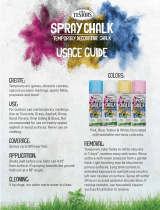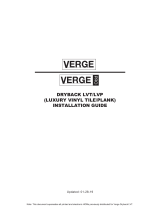Armstrong Flooring 51915031 Installation guide
- Type
- Installation guide

Vinyl Composition Tile
Installation System
Product Gauge Size
Adhesive/
Full Spread
Adhesive/
Tile-On
Vinyl No-Wax
(Dry Back)
0.045"
(1.1 mm)
Feature Strips:
1" (2.5 cm),
2" (5.0 cm) or
6" x 24"
(15.2 cm x 61 cm)
all others 12" x 12"
(30.5 cm x 30.5 cm)
S-515, S-525,
S-700, or S-750
S-515, S-525, or
S-750
Urethane No-Wax
(Dry Back)
0.080"
(2.0 mm)
IMPERIAL TEXTURE 0.094"
(2.4 mm)
STONETEX
ChromaSpin
COMPANION SQUARE
Feature Tile/Strips
IMPERIAL TEXTURE
RAVE
MULTICOLOR
0.125"
(3.2 mm)
ARTEFFECTS 0.125"
(3.2 mm)
RAFFIA 0.125"
(3.2 mm)
12" x 24"
(30.5 cm x 61 cm)
SAFETY ZONE
0.125"
(3.2 mm)
12" x 12"
(30.5 cm x 30.5 cm)
S-515, S-525,
S-700, S-750, or
S-240
Installation:
Location: All grade levels
Suitable Substrates:
All substrates listed below must be properly prepared and meet the
requirements discussed in Chapter III, Subfloors and Underlayments. There
may be certain exceptions and special conditions for these substrates to be
suitable for the Vinyl Composition Tile Installation System.
Full Spread:
• Concrete • Ceramic Tile, Terrazzo, Marble
• Approved Suspended Wood • Polymeric Poured
(seamless) Floors
• Steel, Stainless Steel, Aluminum,
Lead, Copper, Brass, Bronze
Tile-On:
• Existing Resilient Sheet Floors
• Vinyl Composition, Vinyl Asbestos, Asphalt, Rubber and Vinyl Tile-on
Grade or Suspended Only

Job Conditions/Preparation:
• Resilient flooring should only be installed in temperature-controlled
environments. It is necessary to maintain a constant temperature before,
during, and after the installation. Therefore, the permanent or temporary
HVAC system must be in operation before the installation of resilient
flooring. Portable heaters are not recommended as they may not heat the
room and subfloor sufficiently. Kerosene heaters should never be used.
• Substrates must be dry, clean, smooth, and free from paint, varnish, wax,
oils, solvents and other foreign matter. In renovation or remodel work,
remove any existing adhesive residue* so that no ridges or puddles are
evident and a thin, smooth film remains.
• When using S-240 Epoxy Adhesive, remove any existing adhesive residue*
so that 80% of the overall area of the original substrate is exposed. If these
requirements are not followed, curled and/or loose tile could result. For Tile-
On, remove wax or other finishes with a commercially available liquid wax
stripper. Replace or repair indented or otherwise damaged areas.
• Allow all flooring materials and adhesives to condition to the room
temperature for a minimum of 48 hours before starting the installation.
• The area to receive the resilient flooring should be maintained at a minimum
of 65°F (18°C) and a maximum of 100°F (38°C) for 48 hours before, during,
and for 48 hours after completion. When using S-240 Epoxy Adhesive, the
maximum room temperature should not exceed 85°F (29°C).
• During the service life of the floor, the temperature should never rise above
100°F (38°C) nor fall below 55°F (13°C). The performance of the flooring
material and adhesives can be adversely affected outside this temperature
range.
• For concrete substrates, conduct moisture testing (moisture vapor emission
rate [MVER]) and/or percent relative humidity (in-situ probe). Bond tests
must also be conducted for compatibility with the substrate. Please refer to
Chapter III, Subfloors and Underlayments.
• Radiant-heated substrates must not exceed a maximum surface temperature
of 85°F (29°C).
• Concrete floors should be tested for alkalinity. The allowable readings for
the installation of Armstrong flooring are 5 to 9 on the pH scale.
Precautions:
• S-240 Epoxy Adhesive is recommended for SAFETY ZONE in areas that may
be exposed to frequent surface moisture and/or cooler temperatures.
• S-240 Epoxy Adhesive may also be used to install the first 3 to 5 rows of
SAFETY ZONE when used in areas that will be affected by surface moisture
and/or cooler temperatures.
• Tiles are to be heated from the back only, never the face.
* Some previously manufactured asphaltic “cutback” adhesives contained asbestos (see warning
statement on page x). For removal instructions, refer to the Resilient Floor Covering Institute’s
publication Recommended Work Practices for Removal of Resilient Floor Coverings.

• Do not wash tile for at least 4 days after installation. This will allow the tile
to become well seated in the adhesive and prevent excess moisture and
cleaning agents from interfering with the adhesive bond.
• Products installed using the Tile-On System may have less resistance to
indentation. We strongly recommend the use of Armstrong Floor Protectors.
Fitting:
Before installing the material, plan the layout so tile joints fall at least 6"
(15.2 cm) away from subfloor/underlayment joints. Do not install over
expansion joints.
When installing over an existing resilient floor, plan the layout so the new
joints are a minimum of 6" (15.2 cm) away from the original seams. When
installing over tile floors, joints should fall in the center of the tile.
When installing 12" x 12" (30.5 cm x 30.5 cm) tiles, avoid having border pieces
less than 6" (15.2 cm) wide.
Abutting Different Gauges of Resilient Flooring: When installing thinner
gauge material next to thicker gauge materials, install thicker material first
and then butt a 12" (30.5 cm) wide piece of S-153 Scribing Felt against the
thicker material. Adhere the Scribing Felt to the subfloor with S-235 Adhesive.
Use the fine notching of the S-891 Trowel over nonporous substrates such as
existing resilient flooring, and use the regular notching of the S-891 Trowel
over porous subfloors such as wood and concrete. Use S-184 Fast-Setting
Cement-Based Patch and Skim Coat or S-194 Patch, Underlayment and
Embossing Leveler to feather the edge of the S-153 Scribing Felt to the level of
the substrate. Allow the patch to dry completely before installing the flooring.
Scribing Felt is not recommended to be used under the entire installation.
Adhesive Open Times and Trowel Notchings
Adhesive Open Time Working Time
S-515 Approximately 30 minutes or more 24 hours
S-525 Approximately 20 minutes or more 24 hours
S-700 Approximately 30 minutes or more 18 hours
S-750 Approximately 30 minutes or more 6 hours
S-240 Minimum 20 minutes 1 hours
NOTE: All adhesives except S-240 Epoxy Adhesive should be dry-to-touch
before installing tile. The amount of open time will vary according to
job conditions, temperature, humidity, air flow and type of substrate. All
adhesives are applied with fine notching [1/32" (0.8 mm) deep, 1/16" (1.6 mm)
wide, 5/64" (2 mm) apart].
Procedure:
See Adhesives, Seam Treatments and Grout.
When using tile from two or more cartons, check to be sure all pattern and lot
numbers are the same to ensure proper color match. On larger installations,

87
open several cartons and mix them as they are installed to help blend any
slight shade differences from one carton to the next.
Tile products with directional arrows on the back should be installed with the
arrows all pointing in the same direction.
• Tile Installed Using S-515, S-525, S-700 or S-750:
1. Line off entire area to be installed.
2. Apply the adhesive over the area not covering the chalk lines and using
the fine notching of the S-891 Trowel. You may prefer to spread and install
one quarter of the room at a time.
3. Allow the adhesive to set until dry-to-touch (except S-240) following the
recommended open time. To test, press your thumb lightly on the surface
of the adhesive in several places. If the surface feels slightly tacky as your
thumb is drawn away and does not stick to your thumb, the adhesive is
ready for the installation.
4. Install the tile along the chalk lines, laying the field area first and then
fitting in the border tile.
5. Roll all residential tile and SAFETY ZONE in both directions within the
adhesive working time using a 100-lb. roller.
6. Clean adhesive from the surface of the tile using a clean white cloth
dampened with a neutral detergent and water.
7. Tile should not be exposed to rolling load traffic for at least 72 hours after
installation to allow setting and drying of the adhesive.
• SAFETY ZONE in Specialty Areas:
1. Line off entire area to be installed (Fig. 4).
2. Move chalk lines to one corner or end of the area farthest from the
doorway. These lines should be 2' or 3' from the wall depending on your
reach (Fig. 5).
3. Mix the entire contents of Part A and Part B together with a stirring
motion while at the same time lifting from the bottom. Mix thoroughly
for 3 to 5 minutes to a uniform color. Do not over mix. Never mix S-240
Epoxy Adhesive on the subfloor surface.
4. Immediately pour the entire unit of mixed adhesive onto the subfloor.
Do not leave mixed adhesive in cans because it shortens pot life and
S-240 Adhesive
Fig. 4 Fig. 5

working time, and may generate excessive heat. Maximum pot life of
the S-240 Epoxy Adhesive is approximately 10 minutes depending on
temperature and atmospheric conditions.
5. Apply S-240 Epoxy Adhesive for only 2 or 3 rows of tile. Working time of
S-240 Epoxy Adhesive is approximately 1 hour.
6. Tile may be placed into the adhesive immediately, but allowing 15 to 20
minutes of open time and fitting border tile tightly will reduce tile shifting
and adhesive oozing. Do not allow the adhesive to dry completely.
7. Install tile with the arrows on the back of the tile pointing in the same
direction.
8. Roll tile in both directions within 1 hour of spreading S-240 Epoxy
Adhesive using a 100-lb. roller. Re-roll 1 hour later in both directions.
Remove adhesive residue from the surface of all the tile immediately
using a clean, white cloth dampened with neutral detergent and water.
Dried S-240 Epoxy Adhesive cannot be removed.
9. Do not work on newly adhered tile except to roll tile. Use a kneeling
board if necessary.
10. Repeat Steps 4 through 9 until the entire area is completed.
11. Do not allow traffic on tile for 24 hours after installation.
12. Flooring should not be exposed to rolling load traffic for at least 72 hours
after installation to allow setting and drying of the adhesive.
© 2016 AFI Licensing LLC.
Armstrong® and Armstrong Logo are trademarks of AWI Licensing LLC.
All other marks are trademarks of Armstrong Flooring, Inc. or its subsidiaries.
-
 1
1
-
 2
2
-
 3
3
-
 4
4
-
 5
5
Armstrong Flooring 51915031 Installation guide
- Type
- Installation guide
Ask a question and I''ll find the answer in the document
Finding information in a document is now easier with AI
Related papers
-
Armstrong Flooring 51938031 Installation guide
-
Armstrong Flooring U506165L Installation guide
-
Armstrong Flooring 693408K Installation guide
-
Armstrong Flooring G1087401 Installation guide
-
Armstrong Flooring A3266451 Installation guide
-
Armstrong Flooring A3263851 Installation guide
-
Armstrong Flooring A3230051 Installation guide
-
Armstrong Flooring A3239051 Installation guide
-
Armstrong AR-696718 Installation guide
-
Armstrong Flooring K100264P Installation guide
Other documents
-
Armstrong 55808231 Installation guide
-
Armstrong T3504031 Installation guide
-
MARAZZI 0000HDSAMULN9 Operating instructions
-
TrafficMASTER ULMK18181PV Operating instructions
-
 Testors 306006 User manual
Testors 306006 User manual
-
Armstrong A6206161 Installation guide
-
Armstrong 55800231 Installation guide
-
daltile CC071818HD1PV Operating instructions
-
ROPPE 2D60964P639 Installation guide
-
 Verge D327515 Installation guide
Verge D327515 Installation guide






